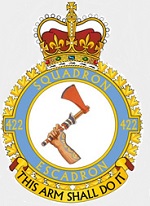Corgi AA27502 RCAF Short Sunderland Mk. III Flying Boat - ML788/2-S, No.422 Squadron, Pembroke Dock (1:72 Scale)
This arm shall do it"
- Motto of No.422 Squadron
 The Short S.25 Sunderland was a British flying boat patrol bomber developed for the Royal Air Force (RAF) by Short Brothers. It took its service name from the town (later, city) and port of Sunderland in northeast England.
The Short S.25 Sunderland was a British flying boat patrol bomber developed for the Royal Air Force (RAF) by Short Brothers. It took its service name from the town (later, city) and port of Sunderland in northeast England.
Based in part upon the S.23 Empire flying boat, the flagship of Imperial Airways, the S.25 was extensively re-engineered for military service. It was one of the most powerful and widely used flying boats throughout the Second World War, and was involved in countering the threat posed by German U-boats in the Battle of the Atlantic. RAF Sunderlands also saw service throughout the Korean War and continued in service until 1959. It also took part in the Berlin airlift. Sunderlands remained in service with the Royal New Zealand Air Force (RNZAF) until 1967.
Sunderlands converted for civil use, known as Short Sandringhams, continued in airline operation until 1974. A single airworthy example remains on display in Florida at Fantasy of Flight. A sunken Mark I Sunderland, identified as the Sunderland T9044 of No 210 Squadron, RAF, was discovered in 2000 off the coast of Wales; there are plans to raise it in the near future.
Pictured here is a 1:72 scale replica of a RCAF Short Sunderland Flying Boat that was attached to No.422 Squadron, then deployed to Pembroke Dock.
Sold Out!
Dimensions:
Wingspan: 18-3/4-inches
Length: 14-1/4-inches
Release Date: September 2016
 Historical Account: "Flying Porcupine" - The Short Sunderland Mk.III proved to be the definitive version of what was the RAF's largest aircraft of the War. As the electronic detection of enemy U-boats became essential in disrupting their operations, the earlier stickleback radar antennas on the spine of the aircraft were replaced with the later and more capable ASV. MK.III units, which were housed in streamlined blisters underneath each wing, outboard of the floats as modelled here. As U-boats could now detect approaching RAF aircraft with their own radar sets, these new radar blisters operated outside the frequencies used by the previous units and ensured that Coastal Command Sunderlands continued to keep marauding U-boats fearful of attack from the air.
Historical Account: "Flying Porcupine" - The Short Sunderland Mk.III proved to be the definitive version of what was the RAF's largest aircraft of the War. As the electronic detection of enemy U-boats became essential in disrupting their operations, the earlier stickleback radar antennas on the spine of the aircraft were replaced with the later and more capable ASV. MK.III units, which were housed in streamlined blisters underneath each wing, outboard of the floats as modelled here. As U-boats could now detect approaching RAF aircraft with their own radar sets, these new radar blisters operated outside the frequencies used by the previous units and ensured that Coastal Command Sunderlands continued to keep marauding U-boats fearful of attack from the air.
The sight of large numbers of these impressive flying boats operating from RAF Pembroke Dock must have been awe inspiring for anyone lucky enough to witness it. At one time, this was the largest seaplane base in the world, this Welsh coastal town was to become crucially important in the Battle of the Atlantic. The Short Sunderland was nicknamed the "Flying Porcupine" by the German forces because of its fantastic defensive and offensive capabilities.





![USAF General Dynamics F-16C Viper Fighter - 457th Fighter Squadron "Spads", "75th Anniversary", November 2020 [Anniversary Scheme] (1:72 Scale)](http://cdn4.volusion.store/qh9e9-jdqv9/v/vspfiles/photos/HA3884-1.jpg?v-cache=1740197136)
